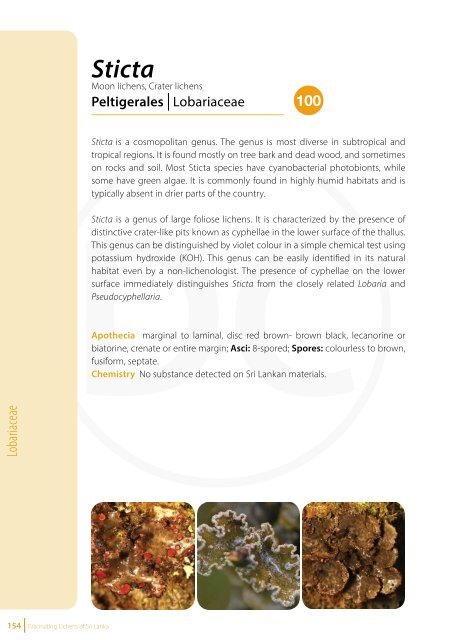Fascinating Lichens of Sri Lanka
Fascinating Lichens of Sri Lanka
Fascinating Lichens of Sri Lanka
- No tags were found...
Create successful ePaper yourself
Turn your PDF publications into a flip-book with our unique Google optimized e-Paper software.
Sticta<br />
Moon lichens, Crater lichens<br />
Peltigerales Lobariaceae<br />
100<br />
Sticta is a cosmopolitan genus. The genus is most diverse in subtropical and<br />
tropical regions. It is found mostly on tree bark and dead wood, and sometimes<br />
on rocks and soil. Most Sticta species have cyanobacterial photobionts, while<br />
some have green algae. It is commonly found in highly humid habitats and is<br />
typically absent in drier parts <strong>of</strong> the country.<br />
Sticta is a genus <strong>of</strong> large foliose lichens. It is characterized by the presence <strong>of</strong><br />
distinctive crater-like pits known as cyphellae in the lower surface <strong>of</strong> the thallus.<br />
This genus can be distinguished by violet colour in a simple chemical test using<br />
potassium hydroxide (KOH). This genus can be easily identified in its natural<br />
habitat even by a non-lichenologist. The presence <strong>of</strong> cyphellae on the lower<br />
surface immediately distinguishes Sticta from the closely related Lobaria and<br />
Pseudocyphellaria.<br />
Lobariaceae<br />
Apothecia marginal to laminal, disc red brown- brown black, lecanorine or<br />
biatorine, crenate or entire margin; Asci: 8-spored; Spores: colourless to brown,<br />
fusiform, septate.<br />
Chemistry No substance detected on <strong>Sri</strong> <strong>Lanka</strong>n materials.<br />
Sticta limbata<br />
SL<br />
Description Foliose. The thallus is reniform (kidney like) to irregular, and loosely<br />
attached at one point. The lobes are broad, round, margins thickened and<br />
densely sorediate. The upper surface is greyish green to brown when dry, and<br />
greyish-brown to reddish when wet. The lower surface is pale yellowish brown to<br />
grey-brown to dark reddish brown, Cyphellae sparse and rounded. Apothecia are<br />
not seen on the material collected in <strong>Sri</strong> <strong>Lanka</strong>.<br />
R<br />
Fo<br />
Lobariaceae<br />
Status Rare species. Careful observation is needed, as it has only been spotted<br />
only once. New record for <strong>Sri</strong> <strong>Lanka</strong>.<br />
Habitat Seen in the humid high elevation montane forest <strong>of</strong> the Kalupahana-<br />
Knuckles region only. This species could be restricted to montane forests. Found<br />
at shady, highly humid sites, growing together with mosses.<br />
Locations Kalupahana area in the Knuckles mountain region.<br />
154 <strong>Fascinating</strong> <strong>Lichens</strong> <strong>of</strong> <strong>Sri</strong> <strong>Lanka</strong><br />
<strong>Fascinating</strong> <strong>Lichens</strong> <strong>of</strong> <strong>Sri</strong> <strong>Lanka</strong> 155
















